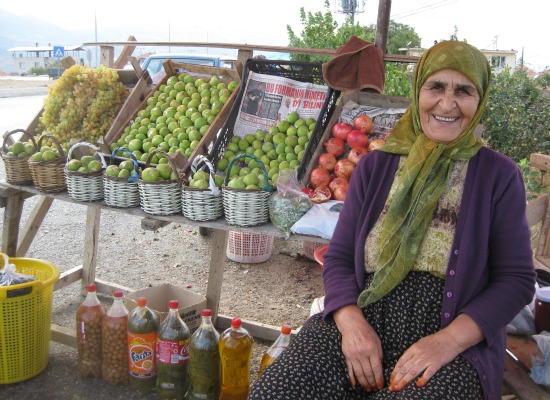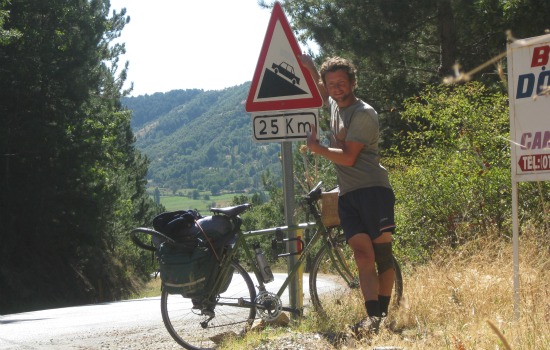The Figs and Mountains of Izmir
Travel horizontally in any direction and you see no change in landscape; Siberia remains Siberia from Finland to Kamchatka
/https://tf-cmsv2-smithsonianmag-media.s3.amazonaws.com/filer/20111101011011FigDrippingWebCropped.jpg)
Izmir is to the fig what Bordeaux is to wine. The fruit didn’t originate here, but the region produces more and probably better figs than almost anywhere else. Those large, chewy, sugar-encrusted, dried Turkish figs that you find at some natural foods stores were likely grown in the prosperous valleys near Izmir. So renowned were this region’s figs in America even 130 years ago that California entrepreneurs of the time, keen on becoming fig farmers, imported wood cuttings of Turkey’s best fig trees from the southwest Smyrna region, especially the Sari Lop variety. They planted the trees by the thousands in the Sacramento and San Joaquin Valleys. It took several years of failed crops for farmers to discover that a particular species of pollinating wasp was also needed for the figs to ripen, and so the U.S. Department of Agriculture isolated, imported and released the Eurasian bug in California. That did the trick, and at last, at the turn of the 20th century, the first bumper crops of California Sari Lop figs arrived. In honor of its old and its new homelands, the variety was renamed the Calimyrna. The San Joaquin Valley would become the nucleus of New World fig production.
Especially in the Menderes River drainage near the city of Aydın, fig trees cover almost every fold of earth deep into mountain ravines and across the valley floor. In warehouses and empty shop fronts, four-foot-deep heaps of dried figs spill out of doorways, waiting to be exported to the world, and fresh figs are sold along roadways and carefully packed and sent around the nation. Those who enjoy roadside fig hunting may be in paradise here, though the sport should be pursued with respect and restraint. Orchards are off limits, of course, while any trees dropping figs to the pavement are fair game for plundering, in my mind.
And though more figs grow here than most other places, Turkey produces more of almost every other crop as well. Its apple harvest, for instance, was more than 20 times greater than its fig harvest in 2008—the former weighing 2.5 million tons over the fig’s national total of 205,000 tons—and the fact remains that almost no one, anywhere, eats figs.
Entering the region from the northeast, the first thing that caught my eye was not the fig trees but the beautiful Bozdag Mountains. They loomed on the horizon, just south of the Gediz River valley. The Bozdags stand as high as two miles above sea level—and they climb to these heights from sea level, or just about, making for the sharpest of geographic relief and thrilling scenery. As I drew near, I saw deep, shadowy ravines and canyons slicing into the north-facing flank of the mountains, and I could see the orchards petering out on the slopes and giving way to the pines and granite of altitude. When I came to a road sign pointing into the mountains to a town called Bozdag, I bagged some figs, bought some almonds and broke for it.
The valley dropped below me, and thunderheads hanging over the Gediz valley turned pink and blue as the sun went down. On the mountainside there was no flat ground to camp on, and I raced onward for the top, turning my blinking lights on as darkness fell. The stars were out when I finally reached level ground, and I pulled up by a fruit shack to ask the owner if I could camp in his adjacent picnic patch. He was a bit flustered by my sudden appearance, but he shrugged and said yes. “Here, please, 5 lira,” I said, handing over a bill. He looked puzzled but accepted without taking insult, and I made my camp as the night’s chill set in. For the next five days, I bounced back and forth between the parallel east-west Aydin and Bozdag mountain ranges, dropping each morning into the green lowlands and spending the afternoons on long, laborious, out-of-saddle climbs back into the summits. Climbing by bicycle into the peaks of wild and strange mountains is one of the greatest joys I know—though I’ve met touring cyclists who avoid hills and highlands like sailors might a notoriously nasty shoal. They nervously study their maps and hug the coastlines and follow the main roads and, I suppose, never know what thrills they’re missing.
But touring this region wasn’t all fun and games, high roads and mountain air, because I was a tourist, and I had important work to do. Precisely, I had to go visit Ephesus, renowned as one of the most stunning ruined cities of the Roman era. But when I got there, I reeled backward from the wildest circus of mayhem, gridlock and crowds I’d seen since rush hour at Beşiktaş. I hadn’t met a single tourist in days, and in the parking lot of Ephesus were least a hundred full-sized buses, fleets of taxis, and several thousand people. What appetite I ever had for Roman amphitheatres and pillars of fluted marble evaporated in an instant. I sat on a bench in the shade for 30 minutes, dazed by the chaos, tormented by indecision, and unsure whether to bounce back into the mountains or do my duty and enter this ancient place. Finally, I stood. “Our history blogger will never forgive me,” I muttered, but there were no regrets as I rolled out the exit. A surprise northward tailwind picked me up from behind, and my spirits exploded like the full billowing sail of a racing catamaran. Giddy and glad, I sprinted north, and by dusk I was hauling my way uphill for my last beautiful night in the Bozdag Mountains.
Why do I love mountains? Because they’re there. Wait—no. That’s a weak answer. Here’s why: Mountains transform worlds. One may travel thousands of miles horizontally in any direction and see little or no change in the landscape; pedal across Siberia, and it remains Siberia from Finland to Kamchatka. But travel just 4,000 feet vertically, and the world around you rapidly transforms. Climate zones come, and they go. The tree fruits vanish as chestnuts and pines appear, and thrilling views open across the widening vista. Boredom, which rules the flatlands of sea level, dissolves, and while blubbery cows may graze listlessly in the hot, dreadful valleys, in the cool air of the summits and passes are sleek wild horses, bears and wolves. There are even parts in southern Turkey where an afternoon’s ride can take you from muggy, subtropical banana groves into a landscape resembling tundra. How incredible is that? In the Bozdag and Aydin ranges, so thrilling was the act of climbing that most evenings I was still pedaling well after dark by the light of my headlamp. I just never wanted to quit.
And the people! They were as collectively warm and generous as any I’d met. One morning in the Aydins, a huge Kangal stud leaped off a bank, bent on my destruction and snarling savagely in my path. A young man, attracted by the ruckus, hurried up a dirt driveway. “Mustafa!” he scolded, which turned the dog friendly. The family had me in for tea, then showed me through their two-acre farm. They gave me a melon, a pile of sweet cherry tomatoes and, of all the kindly but baffling gifts to offer a cyclist on a hot day, four pounds of fresh-cut broccoli. I could think of only one thing to say: “Petrol!” Onward, calls for tea followed me through the region. If I ever complained before about tea invitations, can I take it back? The unstoppable torrent of kindliness, friendly honks and open smiles was phenomenal, and many exchanges with locals sent me away giddy and rapturous—and always, every afternoon, looking for the nearest road up.
Planning Your Next Trip?
Explore great travel deals
Smithsonian magazine participates in affiliate link advertising programs. If you purchase an item through these links, we receive a commission.
/https://tf-cmsv2-smithsonianmag-media.s3.amazonaws.com/accounts/headshot/Off-Road-alastair-bland-240.jpg)


/https://tf-cmsv2-smithsonianmag-media.s3.amazonaws.com/accounts/headshot/Off-Road-alastair-bland-240.jpg)